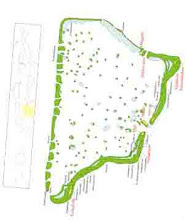























 The classical image of Sri Lanka is the elephants. We will start our four-day visiting the Elephant Orphanage in Pinnawala. A place where they take care of elephants that got injured in car accidents or in the civil war with LTTE. Elephant Orphanage in Pinnawala is place that we will really enjoy and will never forget. Most orphans are accustomed to their curious human visitors are harmless. Started in 1972 the Elephant Orphanage was relocated to at the present site in 1975. Bathing time at Ma Oya just in front of the orphanage is sharp at 10.00am is the magical moment. This is a must if you are visiting Sri Lanka. Having seen the elephants in the orphanage we moved down to the rivers edge and waited a short while. The elephants were then brought down and it was as if they were in the wild. About 100 elephants came down the road in direction to the river. In the river some have a big bath and some others meandering to the other side of the river to throw soil over their backs. Others were drifting down stream and they were left to their own devices for nearly 2 hours.
The classical image of Sri Lanka is the elephants. We will start our four-day visiting the Elephant Orphanage in Pinnawala. A place where they take care of elephants that got injured in car accidents or in the civil war with LTTE. Elephant Orphanage in Pinnawala is place that we will really enjoy and will never forget. Most orphans are accustomed to their curious human visitors are harmless. Started in 1972 the Elephant Orphanage was relocated to at the present site in 1975. Bathing time at Ma Oya just in front of the orphanage is sharp at 10.00am is the magical moment. This is a must if you are visiting Sri Lanka. Having seen the elephants in the orphanage we moved down to the rivers edge and waited a short while. The elephants were then brought down and it was as if they were in the wild. About 100 elephants came down the road in direction to the river. In the river some have a big bath and some others meandering to the other side of the river to throw soil over their backs. Others were drifting down stream and they were left to their own devices for nearly 2 hours.In the way we stopped in a fruit road store and we tried for the first timing the red bananas. The fruits are just great. There are all varieties of fruits in Sri Lanka. We can enjoy fruits like mangoes, pineapple, watermelon, papaya, wood apple, bananas (also known as plantains), and rambuttan (a fruit resembling leeches).
Back to Kandy and the Temple of the Tooth Relic of Buddha. The Holy Temple of the Tooth (Sri Dalada Maligawa) in Kandy is the most sacred shrine of Buddhism.The temple of the Tooth is the prime monument, the supreme edifice not only of the Sinhalese Buddhist populace of Sri Lanka but also of the Buddhists all over the world. It is within this magnificent temple that sacred Tooth relic of Buddha (Danta Dhatu), the palladium of the Sinhalese nation & Buddhist faith is enshrined. The setting of the Holy Temple of the Tooth is scenically located right in the heart of the town, next to (western entrance) the man-made lake named Kiri Muhuda meaning Milk Sea in Sinhala, lined by an unceasing wave-like decorative low white wall running the whole perimeter in & beyond our eye view. The Temple is the central attraction of the town that nestles tightly in the lush valley, in the backdrop of tall green woods of Udawattakele forest Sanctuary. The lake was built solely for the decorative purposes of the Royal City of Kandy in 1807 AD. Today Kandy is a UNESCO World heritage Site. After visiting this wonderful place we leave to dive in to the hill country, destination to Nuwara Eliya visiting in the way the tea factory “Glenloch” and the Ramboda water fall, 329 ft. some big attraction in this area. Also in the way he stop to see a Buddhist procession, and obviously some more colorful photos.
Situated at around 2000m above sea level and surrounded by lush tea plantations Nuwara Eliya is the main hill resort of Sri Lanka and the heart of the tea industry. Once a pleasure retreat place of the European planters the town is still very much an English town with many English style bungalows and buildings. Nuwara Eliya is a good escape for those who miss cool breeze in tropical Sri Lanka at any time of the year. Local tourists flock to this town in their 'season' from March to May when it is the hottest duration for the town. However, there are no many foreigners. We went to the small public market and we some nice fried snacks.
After a long trip we arrived to Slightly Chilled hotel. Is already night at Nallathannniya, the base camp to Adams Peak. After a long trip we arrived to SLIGHTLY CHILLED hotel at NALLATHANNIYA.
















































